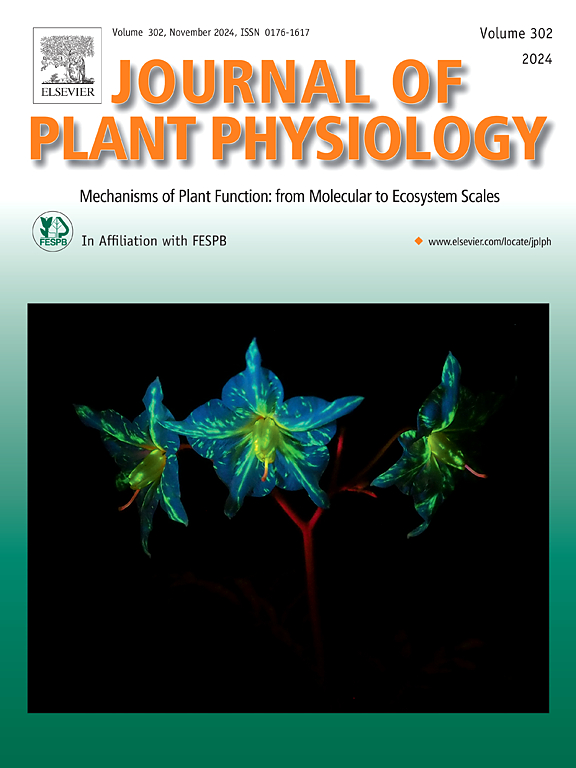Cloning and functional study of AdOPT1, a gene for synthesizing isoimperatorin from Angelica dahurica var. formosana
IF 4.1
3区 生物学
Q1 PLANT SCIENCES
引用次数: 0
Abstract
Angelica dahurica var. formosana (ADF) is a perennial medicinal plant in the Apiaceae family. Its dried roots are rich in furanocoumarins, which exhibit significant pharmacological activities and development potential. The main coumarins in ADF are imperatorin and isoimperatorin. The gene responsible for imperatorin biosynthesis has been reported, but the gene catalyzing isoimperatorin synthesis remains unknown. This study identified a candidate gene, AdOPT1 (1230 bp), from the transcriptome data of ADF through homology-based comparison with AkPT1 in Angelica keiskei, showing 93 % similarity. In vitro functional assays revealed that AdOPT1 catalyzes the oxygen-prenylation reaction between DMAPP and bergaptol to produce isoimperatorin. The kinetic parameters of AdOPT1 for bergaptol and DMAPP were found to be Km bergaptol = 112.9 ± 17.83 μM, Km DMAPP = 1.97 ± 0.08 μM, respectively. Molecular docking and alanine scanning analysis identified critical residues 45Lys, 124His, and 395Trp for AdOPT1 catalytic activity. Under various abiotic stresses such as flooding, salt, drought, and shading treatment, the expression level of AdOPT1 gene in ADF significantly increased, suggesting its involvement in ADF stress resistance. Additionally, transient overexpression of AdOPT1 significantly increased isoimperatorin content, with 3.26-fold higher than the control-group and 3.53-fold higher than the wild-type. It further confirmed that AdOPT1 is responsible for catalyzing the biosynthesis of isoimperatorin in ADF. This provides a molecular theoretical basis for making the biosynthesis pathway of furanocoumarin more comprehensive and helps to breed new high-quality ADF varieties in the future.
台湾白芷异欧前胡素合成基因AdOPT1的克隆及功能研究
台湾白芷(Angelica dahurica var. formosana, ADF)是一种多年生药用植物。其干根富含呋喃香豆素,具有重要的药理活性和开发潜力。ADF中的主要香豆素是欧前胡素和异欧前胡素。负责欧前胡素生物合成的基因已被报道,但催化异欧前胡素合成的基因尚不清楚。本研究通过与当归AkPT1的同源性比较,从ADF转录组数据中鉴定出候选基因AdOPT1 (1230 bp),相似度为93%。体外功能分析表明,AdOPT1催化DMAPP与bergaptol之间的氧-戊烯酰化反应生成异欧前胡素。结果表明,AdOPT1对bergaptol和DMAPP的动力学参数分别为Km bergaptol = 112.9±17.83 μM, Km DMAPP = 1.97±0.08 μM。分子对接和丙氨酸扫描分析确定了AdOPT1催化活性的关键残基45Lys, 124His和395Trp。在洪水、盐、干旱、遮荫等多种非生物胁迫下,ADF中AdOPT1基因的表达量显著升高,提示其参与ADF的抗逆性。瞬时过表达AdOPT1显著提高了异欧前胡素含量,比对照组高3.26倍,比野生型高3.53倍。进一步证实了AdOPT1在ADF中催化异欧前胡素的生物合成。这为进一步完善呋喃香豆素的生物合成途径提供了分子理论基础,有助于今后选育优质ADF新品种。
本文章由计算机程序翻译,如有差异,请以英文原文为准。
求助全文
约1分钟内获得全文
求助全文
来源期刊

Journal of plant physiology
生物-植物科学
CiteScore
7.20
自引率
4.70%
发文量
196
审稿时长
32 days
期刊介绍:
The Journal of Plant Physiology is a broad-spectrum journal that welcomes high-quality submissions in all major areas of plant physiology, including plant biochemistry, functional biotechnology, computational and synthetic plant biology, growth and development, photosynthesis and respiration, transport and translocation, plant-microbe interactions, biotic and abiotic stress. Studies are welcome at all levels of integration ranging from molecules and cells to organisms and their environments and are expected to use state-of-the-art methodologies. Pure gene expression studies are not within the focus of our journal. To be considered for publication, papers must significantly contribute to the mechanistic understanding of physiological processes, and not be merely descriptive, or confirmatory of previous results. We encourage the submission of papers that explore the physiology of non-model as well as accepted model species and those that bridge basic and applied research. For instance, studies on agricultural plants that show new physiological mechanisms to improve agricultural efficiency are welcome. Studies performed under uncontrolled situations (e.g. field conditions) not providing mechanistic insight will not be considered for publication.
The Journal of Plant Physiology publishes several types of articles: Original Research Articles, Reviews, Perspectives Articles, and Short Communications. Reviews and Perspectives will be solicited by the Editors; unsolicited reviews are also welcome but only from authors with a strong track record in the field of the review. Original research papers comprise the majority of published contributions.
 求助内容:
求助内容: 应助结果提醒方式:
应助结果提醒方式:


